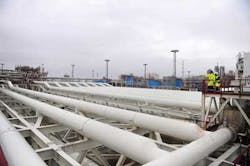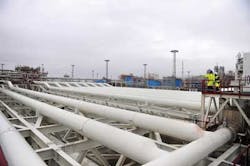Statoil has updated an assay of the condensate stream associated with natural gas being produced from Snohvit field in the Barents Sea.
The field lies on Blocks 7120 and 7121 in the Barents Sea, west northwest of the island of Hammerfest, Norway (OGJ, Apr. 9, 2007, p. 48). It sends natural gas via a 143-km (88.8-mile) subsea pipeline to the world's only gas liquefaction plant, on Melkoye Island. (A map of the field's location appears in OGJ, June 16, 2008, p. 46.)
The gas processing plant at the Hammerfest LNG plant received gas from Snohvit in August 2007 (OGJ, Aug. 27, 2007, p. 10), but full production was delayed by leaks in the cooling system until early 2008 (OGJ, Feb. 4, 2008, p. 10).
Snohvit produces without fixed or floating units in the Barents Sea. Instead, subsea production units stand on the seabed in water 250-345 m deep. A total of 20 wells are to produce gas from the Snohvit, Askeladd, and Albatross fields, says Statoil; 9 wells are planned on Snohvit, including 8 for production and 1 for reinjecting CO2.
Six of the producers and the CO2 injection well were drilled 2004-05, with the remaining two following this year. In addition, production wells were drilled on Albatross in 2005-06; this field also forms part of the Snohvit development. Snohvit and Albatross wells came on stream in 2007; Askeladd is due to come on stream in 2014-15.
Partners in Snohvit are Statoil (operator, 33.53%), Petoro (30%), Total E&P Norge (18.40%), GDF Suez E&P Norge (12%), Hess Norge (3.26%), and RWE Dea Norge (2.81%).
Whole crude
Density at 15º C., kg/l.: 0.7339
Dry oil density15º C., kg/l.: 0.7339
API gravity at 60/60° F.: 61.3
Specific gravity at 60/60° F.: 0.7341
Sulfur, mass %: 0.020
Total acid no.: my KOH/g: <0.01
Reid vapor pressure, kPa: 48.6
Pour point, °C.: <–48
Flash point, °C.: <10
Vis. at 20° C., cst: 0.71
Vis. at 40° C., cst: 0.58
Nitrogen, mg/kg: 3
Hydrogen sulfide, mass %: ND1
Vanadium, mg/kg: <0.1
Nickel, mg/kg: <0.1
Sodium, mg/kg: <0.1
Mercury, µg/k: <1.0
Salt as NaCl, mg/l.: <5.0
Wax content, mass %: NA
Water content, mass %: <0.02
Pentanes to 65° C.
Yield on crude, mass %: 22.63
Yield on crude, vol %: 25.72
Density at 15° C., kg/l.: 0.6433
Specific gravity at 60/60° F.: 0.6433
API gravity at 60/60° F.: 88.5
Mercaptan sulfur, mg/kg: 8
n-Paraffins, mass %: 45.2
i-Paraffins, mass %: 48.5
Naphthenes, mass %: 4.5
Aromatics (incl. benzene), mass %: 1.8
n-Paraffins, vol %: 45.7
i-Paraffins, vol %: 49.1
Naphthenes, vol %: 3.8
Aromatics (incl. benzene), vol %: 1.3
Vapor pressure (DVPE1), kPa: 107.9
Research octane no. (RON): 76.3
Motor octane no. (MON): 73.8
Research octane no. (RON): 276.1
Motor octane no. (MON): 273.6
Displaying 1/4 Page1, 2, 3, 4Next>
View Article as Single page


